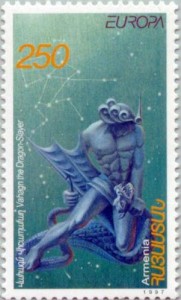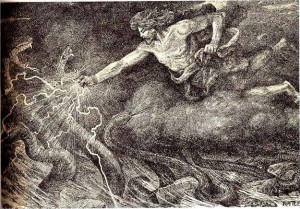The Heritage of Armenian Literature [1] opens up with a chapter about oral tradition. The information about the Armenian oral tradition comes from the History of the Armenians by Moses of Khoren. He mentions different forms of story telling about the ancient Armenian heroes. Zruyts “old and unwritten stories, to which Moses of Khoren attaches a high degree of credibility. Less credible ones, what he terms araspels or legends which he admits sometimes contains historical events… Storyteller’s songs, yergk vipasanats and tvelyatsn yergk, metrical songs, are the other two terms.” Songs were sung by gusans. Gusans sing and compose in performance.
Not many songs survived to this day. When Armenians converted to Christianity, religious leaders were not tolerant of stories that contained ancient Armenian deities. Ironically, all we know from that period came to us by Moses of Khoren who was a man of the church. He understood the importance of the Armenian song culture in understanding the Armenian history and culture.
The Birth of Vahagn is one of the songs Moses of Khoren mentions in his book. Prof. Nagy touched upon this song in Hour 21 of the Ancient Greek Hero in 24 Hours.
…“ I argue, to Indo-European mythology, since there is a corresponding idea attested in Indo-Iranian traditions and assimilated into Armenian heroic narratives (by way of Iranian models). I have in mind here a song preserved in the History of the Armenians by Moses of Khoren (1.31): this song pictures the cosmic moment when the dragon-slayer Vahagn is born from a reed that is said to be in labor as it expels first a burst of smoke, then a burst of flame, and then, out of the flame, a youth with his hair on fire and with eyes that are two suns.”
Gregory Nagy; The Ancient Greek Hero in 24 Hours. Hour 21§50
Here is the song from the History of Armenians by Մովսէս Խորենաձի (Movses Horenatsi) — Moses of Khoren
Երկնէր երկին, երկնէր երկիր
երկնէր եւ ծովն ծիրանի
երկն ի ծովուն ունէր
եւ զկարմրիկն եղեգնիկ.
ընդ եղեգան փող ծուխ ելանէր,
ընդ եղեգան փող բոց ելանէր.
եւ ի բոցոյն վազէր խարտեաշ պատանեկիկ.
նա հուր հեր ունէր,
ապա թէ բոց ունէր մօրուս,
եւ աչկունքն էին արեգակունք:
Yergner yergeen, yergner yergeer
yergner yev zovn zeeranee
yergn oo zovn ooner
yev izgarmeerign yegekneek;
ěnt yegekan pogh zooh yelaner,
ěnt yegekan pogh pots yelaner;
yev ee potsoyn vazer hardeash badanegeeg;
na hoor her ooner,
aba te pots ooner moroos,
yev achgoonkn ein arekagoonkn.
In travail were heaven and earth,
In travail, too, the purple sea!
The travail held in the sea the small red reed.
Through the hollow of the stalk came forth smoke,
Through the hollow of the stalk came forth flame,
And out of the flame a youth ran!
Fiery hair had he,
Ay, too, he had flaming beard,
And his eyes, they were as suns!
Translation by Vahan M. Kurkjian
Another translation is from Indo-European Language and Culture: An Introduction by Benjamin W. Fortson, IV, [page 395]
Heaven was in labor, Earth was in labor
the purple sea was in labor
in the sea of labor pain held the little reed,
along the reed’s stalk rose smoke
along the reed’s stalk rose flame
and from the flame leapt up
a golden hair little boy,
he had hair of flame,
he had a beard of flame
and his eyes were little suns.
Contributions to Comparative Mythology: Studies in Linguistics and Philology edited by Stephen Rudy, pages, 27–29 gives information about the etymology and the cognates of the name Vahagn.
Vahagn is known as the fire-god, god of war and courage. His epithet vishapakagh,‘dragon slayer’, along with the fire element remind us of Hercules.
In this song, the sea is described as purple. Hour 25 hosted a series of blogs on ‘purple sea‘.
Notes
[1] Agop J. Hacikyan, Coordinating Editor, Gabriel Basmajian, Edward S. Franchuk, Nourhan Ouzounian The Heritage of Armenian Literature Volume I From the Oral Tradition to the Golden Age
Image credits
Vahagn the Dragon Slayer, Wikimedia Commons
Vahagn the Dragonslayer engraving by Austrian artist J. Rotter, Wikimedia Commons
Postage stamp, Wikimedia Commons
___
Janet M. Ozsolak is a mother, teacher and active member of Hour 25!
